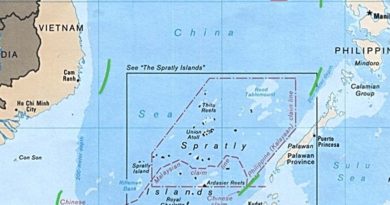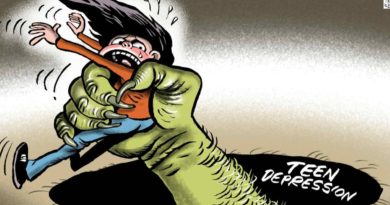OP ED COLUMN: OPINION ON PAGE ONE – Is Cebu now a crime scene?
THIS question has to be asked in light of the latest rush of unsolved killings in this historically peaceful, serene and deeply religious Queen City of the South.
After Fathers Tito Paez of Nueva Ecija, Mark Ventura of Cagayan, and Richmond Nilo also of Nueva Ecija were murdered within a period of six months, topping the record of 13 priests murdered in the country from 1972 to 2016, a suspicious-looking man appeared at the gated compound of the Archbishop of Cebu’s residence on July 10, looking for Archbishop Jose Palma for no declared purpose.
At the time, the Archbishop was in Manila, having attended the mid-year plenary assembly of the Catholic Bishops’ Conference of the Philippines (CBCP), which ended the day before. Palma is a former CBCP president.
A Cebuano doctor friend of mine said he was at the compound that day, and from a distance of so many meters, he heard the man, who was later identified as Jeffrey Canedo from Labangon, Cebu, curse the Church. The man was armed, so the Archbishop’s staff promptly called the police for help. The doctor had to leave the place for his next appointment and did not see what happened next; but the local media later reported the man was killed when he tried to shoot it out with the police.
Palma arrived after the incident, and had to condole with the dead man’s family the next day. The Cebu media carried no further reports about it. But a series of violent incidents followed. These were reported in the city and provincial media as they occurred, and eventually listed chronologically in the August 6 Manila Times column of Marit Stinus-Cabugon, a Cebu-based columnist. The list includes the following:
A summary report
— On July 24, the lifeless bodies of Jamie Mata, age 16, and her boyfriend Stephen del Corro, both of Tisa, Cebu City, were found in Liloan, with bullet wounds in the head. A third body, that of Harry Lloren of Pardo, Cebu City, turned up in Mandaue City that same morning. The three had been seen together the evening before. The motive behind these killings was not known, and no suspects have been apprehended.
— On July 27, “Baby” Earl Rallos, an assistant operations officer of the Philippine Drug Enforcement Agency (PDEA), Region 7, was shot dead near the provincial capitol, while driving along Villalon Drive in Barangay Capitol Site in Cebu City, one of the city’s busiest streets. Motive for the killing was also not known and no suspects have been arrested.
— Police claimed shabu of unknown quantity was recovered from the PDEA officer’s vehicle, but this claim surfaced after the “scene-of-crime operatives” (SOCO) had finished processing the crime scene, and there was no mention of shabu in the SOCO report.
— On July 30, Jessielou Cadungog, a former barangay councilor of Tejero, Cebu City, escaped an assassination attempt after his driver-bodyguard, William Macaslang, shot dead a suspected “would-be police assassin,” PO3 Eugene Calumba, who was riding in tandem with one Michael Banua, who also turned out to be a “police asset.” Macaslang claimed he shot Calumba as soon as he saw him pull out his firearm, but before he could fire at his intended target. His co-rider Banua tried to speed away, but some bystanders caught and mauled him on the spot, executing what looked like a citizen’s arrest.
— The local police, however, have filed murder and frustrated murder charges against Cadungog and his bodyguard, saying the former barangay councilor was on the drug watch list and under police surveillance. No less than Central Visayas Police Director Debold Sinas was reported to have made this statement; he also disclosed, for no apparent good reason, that Cadungog owns 13 different firearms, although all were properly licensed.
— Cagungog is said to be an original stockholder of Oriental Port and Allied Services (Opascor), Cebu’s leading cargo-handling company, established in 1990 and operating at the Cebu international port. He is known to be an independently wealthy man.
— It appears the police are determined to get him, despite his claim that the slain policeman and his co-rider had intended to kill him. The latest report from Cebu claims that someone was able to capture on video the image of the slain policeman pulling out his gun as the tandem approached Cadungog’s vehicle.
— This became the most talked about violent incident in Cebu, but not the last.
— On July 31, Pascual Villarba, recently released from prison, was shot dead by riding-in-tandem gunmen. Like the others, the motive was not known, and no suspects were arrested. To the contrary, it produced two more murders.
— On August 2, two ex-convicts—Ropil Norvaso and Ricky Andujar of Binaliw, Cebu City—were shot dead by three motorcycle-riding gunmen, while coming from Villarba’s wake at the Cebu International Convention Center.
— On the same date, the bodies of Dennis Lastimoso and Donald Flores of B. Rodriguez, Cebu City were found in Gaas, Balamban, adjacent to Cebu City, with bullet holes in their heads and their wrists tied behind their backs.
— On August 8, a second PDEA agent—Von Rian Tecson, 41—was gunned down by two riding-in-tandem pairs—or four assailants—one of them believed to be a woman, some 100 meters outside his residence in Barangay Perrelos in Carcar City. Tecson was reported to be leading some active operations against drug syndicates, and had been receiving death threats, according to his brother who is also on the police force.
Local execs powerless
The crime wave has left the provincial and city governments of Cebu virtually powerless to do anything about it, without the active cooperation and support of the national government. Cebu Gov. Hilario Davide 3rd and Cebu City Mayor Tomas Osmeña are not DU30’s political allies or henchmen and are very much on their own.
The governor’s father, former Supreme Court Chief Justice Hilario Davide Jr., is actively campaigning against DU30’s controversial federalism project, while Osmeña represents the biggest hindrance to the ambitions of DU30’s subalterns who wish to seize control of the city government.
Osmena interiew
On Aug. 10, Osmeña, in an interview with Rappler, said the rise in killings in Cebu “definitely started” after Senior Supt. Royina Garma was assigned as Cebu City Chief of Police, and Chief Supt. Debold Sinas as PNP Regional Director of Central Visayas, without the necessary prior consultations with the local executives concerned.
Garma, the first woman police chief of Cebu, is said to be personally close to DU30 and is seen to exercise more power than any ordinary police chief because of that personal closeness. She replaced the popular Senior Supt. Joel Doria, who enjoyed excellent relations with the community, and with the Commission on Human Rights. She is perceived by close observers to have the same position as DU30 on human rights.
As for Sinas, who used to head the PNP crime laboratory in Camp Crame, observers say he has yet to show he could replicate the record of his predecessor, Chief Supt. Robert Quenery, who succeeded in bringing down index crimes in the region by 35 percent during his watch.
Under the law creating a police force that is civilian in character but national in scope, governors and mayors are supposed to recommend or at least concur in the assignment of police chiefs to their respective regions, cities and municipalities. This is to ensure utmost harmonious cooperation between the local executives and the police officers, who used to be under the direct command and control of the former. It appears Sinas and Garma were named to their respective positions without adequate prior consultations with Davide and Osmeña.
This has obviously created unnecessary problems, which have affected the general peace and order situation in Cebu. More than this, it has created fear among the supporters of the civilian executives concerned that they could end up in some presidential “drug list” and in the same situation as that of some ill-starred political executives who were terminated after that.
The two outstanding cases are those of the late Mayor Rolando Espinosa of Albuera, Leyte and the late Mayor Reynaldo Parojinog of Ozamis City. Espinosa was arrested on drug charges in October 2016, and detained at the Baybay, Leyte provincial jail, where he was killed at 4 a.m. on November 5, 2016, in an alleged “firefight” with special police units from Tacloban, Leyte, after allegedly resisting the service of a search warrant.
Parojinog was killed with his wife and five others during a police raid at his residence on July 30, 2017.
New shabu shipments
Although some notorious politicians and other personalities are threatened with, or arrested on, drug charges after they end up in DU30’s “list of drug suspects,” partisan politics usually appears as the real motive behind the high-profile arrests and killings. Despite the thousands of drug suspects that have been killed since July 2016, there has been no visible serious effort to eliminate the drug menace. The illegal traffic from China, Sinaloa, the Golden Triangle, etc. continues unimpeded.
In August 2017, a large shipment of shabu estimated at P6.4 billion went through the “green lane” at the Bureau of Customs in Manila and ended inside a warehouse in Valenzuela. After months of congressional investigations and media posturing on the part of the authorities, not a single serious case has been filed against a major participant in that crime; the whole thing has been effectively shoved under the rug, as of now. The widely touted “war on drugs” now appears to be not really a war against drugs, but more of a war for the control of illegal drugs. A powerful syndicate, with all the political connections, appears to have gained control of the illegal trade, while all the other players have been, or are being, eliminated.
As this is written, PDEA Director General Aaron Aquino is quoted as saying a large shipment of shabu worth P6.8 billion has illegally entered the country, through the use of “magnetic lifters” that are now inside a warehouse in General Mariano Alvarez in Cavite. A week before that, an illegal shipment worth P4.3 billion was reportedly seized at the Manila International Container Terminal Port. Nobody has been arrested or is being pursued in connection with these crimes.
This means the flow of illegal drugs into the country has not been curbed, and is not likely to be curbed, by DU30’s misguided war on drugs. The new situation in Cebu could be just one more proof that the “territory” of the illegal drug trade and associated crimes is not shrinking but expanding exponentially, despite DU30’s claims of success in his so-called war on drugs.
One can only weep over Cebu becoming the latest region of the country to be hit by this menace. There was a time when, because of the bad image of Manila and the rest of the country, not too many tourists were coming to the Philippines, the provincial government of Cebu chose to lure tourists to the island by advertising Cebu not as a part of the Philippines, but as “an island in the Pacific.” The new crime wave appears to have wiped that out forever.
Whenever I want to take a break from the unbearable Manila traffic, and a few other unbearable things, I would take off for a day or two to Cebu to refresh my spirits. But the last time I asked a friend, “How’s Cebu?”, he said, “It’s now become a crime scene.” What a shame!
 All photographs, news, editorials, opinions, information, data, others have been taken from the Internet ..aseanews.net | [email protected] |.For comments, Email to :D’Equalizer | [email protected] | Contributor
All photographs, news, editorials, opinions, information, data, others have been taken from the Internet ..aseanews.net | [email protected] |.For comments, Email to :D’Equalizer | [email protected] | Contributor









